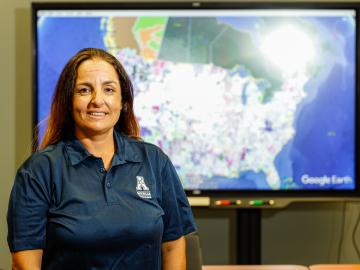
Filter News
Area of Research
- (-) Computer Science (7)
- (-) Energy Science (74)
- (-) Nuclear Systems Modeling, Simulation and Validation (1)
- Advanced Manufacturing (1)
- Biology and Environment (37)
- Biology and Soft Matter (1)
- Computational Engineering (2)
- Electricity and Smart Grid (2)
- Energy Sciences (1)
- Fusion and Fission (6)
- Fusion Energy (6)
- Isotopes (1)
- Materials (19)
- Materials for Computing (4)
- Mathematics (1)
- National Security (16)
- Neutron Science (9)
- Nuclear Science and Technology (11)
- Quantum information Science (7)
- Sensors and Controls (1)
- Supercomputing (36)
News Type
News Topics
- (-) Advanced Reactors (3)
- (-) Energy Storage (41)
- (-) Grid (29)
- (-) Machine Learning (6)
- (-) Quantum Science (2)
- 3-D Printing/Advanced Manufacturing (45)
- Artificial Intelligence (7)
- Big Data (4)
- Bioenergy (12)
- Biology (6)
- Biomedical (3)
- Biotechnology (2)
- Buildings (24)
- Chemical Sciences (4)
- Clean Water (7)
- Composites (11)
- Computer Science (25)
- Coronavirus (7)
- Critical Materials (4)
- Cybersecurity (5)
- Environment (33)
- Fossil Energy (1)
- High-Performance Computing (4)
- Hydropower (3)
- Materials (17)
- Materials Science (13)
- Mathematics (2)
- Mercury (2)
- Microelectronics (1)
- Microscopy (4)
- Nanotechnology (3)
- National Security (1)
- Neutron Science (2)
- Nuclear Energy (4)
- Partnerships (4)
- Polymers (6)
- Security (3)
- Simulation (2)
- Space Exploration (3)
- Statistics (1)
- Summit (2)
- Transportation (43)
Media Contacts

Researchers at ORNL demonstrated that sodium-ion batteries can serve as a low-cost, high performance substitute for rechargeable lithium-ion batteries commonly used in robotics, power tools, and grid-scale energy storage.

The formation of lithium dendrites is still a mystery, but materials engineers study the conditions that enable dendrites and how to stop them.

Oak Ridge National Laboratory researchers created a geothermal energy storage system that could reduce peak electricity demand up to 37% in homes while helping balance grid operations.

Nuclear scientists at Oak Ridge National Laboratory have established a Nuclear Quality Assurance-1 program for a software product designed to simulate today’s commercial nuclear reactors – removing a significant barrier for industry adoption of the technology.

To better determine the potential energy cost savings among connected homes, researchers at Oak Ridge National Laboratory developed a computer simulation to more accurately compare energy use on similar weather days.

ORNL computer scientist Catherine Schuman returned to her alma mater, Harriman High School, to lead Hour of Code activities and talk to students about her job as a researcher.

Isabelle Snyder calls faults as she sees them, whether it’s modeling operations for the nation’s power grid or officiating at the US Open Tennis Championships.

Oak Ridge National Laboratory is training next-generation cameras called dynamic vision sensors, or DVS, to interpret live information—a capability that has applications in robotics and could improve autonomous vehicle sensing.

Researchers at Oak Ridge National Laboratory are taking inspiration from neural networks to create computers that mimic the human brain—a quickly growing field known as neuromorphic computing.

A team of researchers at Oak Ridge National Laboratory have demonstrated that designed synthetic polymers can serve as a high-performance binding material for next-generation lithium-ion batteries.


